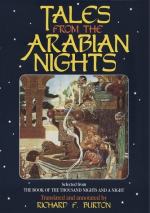Les trots Freres. Here a Ghul is killed by a single blow from a magic dagger, which must not be repeated. (Cf. Nights, vii., p. 361.) In this story, too, the protection of a Ghulah is secured by tasting her milk, a point which we find in Spitta Bey’s “Comes Arabes Modernes,” but not in the Nights.
9. Turkish Evening Entertainments. “The Wonders of Remarkable Incidents and the Rarities of Anecdotes,” by Ahmed ibn Hemdem the Kethhoda called “Sobailee.” Translated from the Turkish by John F. Brown. 8vo., New York, 1850.
Contains a great number of tales and anecdotes, divided into 37 chapters, many of which bear such headings as “Illustrative of intelligence and piety,” “On justice and fostering care,” “Anecdotes about the Abbaside Caliphs,” &c.
“A translation of the Turkish story-book, ’Aja’ib al-ma’asir wa ghara ’ib ennawadir,’ written for Muad the Fourth Ottoman Sultan who reigned between 1623-40. A volume of interesting anecdotes from the Arabic and Persian” (Mr. L. C. Smithers, in litt.).
10. Contes Arabes Modernes, recueillis et traduits par Guillaume Spitta-Bey. 8vo., Leyden and Paris, 1883.
This book contains 12 orally collected tales of such great importance from a folk-lore point of view that I have given full abstracts of all. They are designed to illustrate the spoken Egyptian dialect, and are printed in Roman character, with translation and glossary. The hero of nearly all the tales is called “Mohammed l’Avise,” which Mr. Sydney Hartland renders “Prudent,” and Mr. W. A. Clouston “Discreet.” The original gives “Essatir Mehammed.” (Al-Shatir Mohammed, i.e., M. the Clever.) The frequent occurrence of the number 39 (forty less one) may also be noted. Ghuls often play the part which we should expect Jinn to fill. The bear, which occurs in two stories, is not an Egyptian animal. Having called attention to these general features we may leave the tales to speak for themselves.
I. Histoire de Mohammed l’Avise.
Contains the essential features of Cazotte’s story of the Maugraby (cf. Nights, x., p 418) with interesting additions. The “Mogrebin” confers three sons on a king and queen and claims Mohammed, the eldest and the cleverest. He gives him a book to read during his absence of 30 days, but on the 29th day he finds a girl hanging by her hair in the garden and she teaches him to read it, but not to tell the magician. The latter cuts off his arm threatening to cut off his head if he cannot read the book within another 30 days. As soon as he is gone, Mohammed reads on his arm again with the book, and escapes with the girl when they separate and return to their respective homes. Mohammed then changes himself into a sheep for his mother to sell, but warns her not to sell the cord round his neck. Next day he changes himself into a camel, forbidding his mother to sell the bridle but she is persuaded to do so, and he falls into the hands of




